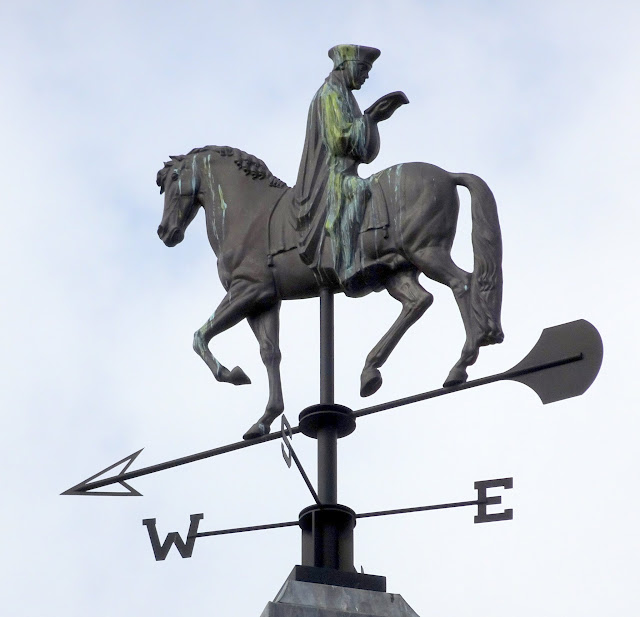 Gradually they became more elaborate and gained other functions such as the display of the heads of traitors and other malefactors.
Gradually they became more elaborate and gained other functions such as the display of the heads of traitors and other malefactors.The grandest bar of all was the one on the ceremonial route between the Palace of Westminster and St Pauls, which was regularly used by the monarch on national events. It became known as Temple Bar after the Templar's round church close by.
 In 1670 a new bar was built in stone as part of the reconstruction programme after the Great Fire. In Victorian times however it was seen as gloomy reminder of times gone by and an obstruction to traffic. It was after much soul-searching removed stone by stone and ended up in the park of a grand house in Hertfordshire. In 2004 it was re-erected near to St Pauls.
In 1670 a new bar was built in stone as part of the reconstruction programme after the Great Fire. In Victorian times however it was seen as gloomy reminder of times gone by and an obstruction to traffic. It was after much soul-searching removed stone by stone and ended up in the park of a grand house in Hertfordshire. In 2004 it was re-erected near to St Pauls.Many felt the bar should not be replaced at all, especially as the road is particularly narrow at that point. Many proposals were made including one by George Street, who was designing the Royal Courts of Justice to the north of the site, who envisaged a gothic style bridge for judges to cross from the Temple. Other ideas included raising the old Temple Bar on a new arch, and making a traffic circus round it. The refusal of Child's Bank on the other side of the road to release land scuppered all these plans.
 The design was eventually given to Horace Jones, architect of Tower Bridge, who created a slender column intended to allow traffic to flow more freely.
The design was eventually given to Horace Jones, architect of Tower Bridge, who created a slender column intended to allow traffic to flow more freely. There is something about public sculpture that provokes Times letter writers to apoplexy, and this project was the subject of a particularly entertaining row. Everything from the continued traffic obstruction, lax organisation, shenanigans on the committee and, of course, the cost were gleefully attacked.
There is something about public sculpture that provokes Times letter writers to apoplexy, and this project was the subject of a particularly entertaining row. Everything from the continued traffic obstruction, lax organisation, shenanigans on the committee and, of course, the cost were gleefully attacked.Particular vilification was directed at the figure on top, London's symbolic dragon as modeled by Charles Birch. For some reason many correspondents seem to think it is a griffin which of course it is not (a griffin has the body of a lion with the head and wings of an eagle: a dragon is a winged serpent.) It was booed by the crowd when the memorial was unveiled in 1880.
In today's eyes, however, the memorial is a typical piece of fussy, sentimental and overblown Victoriana.
The memorial is covered in carving. On the south side is a statue of Queen Victoria by her favourite sculptor, Joseph Boehm - she had dropped hints to the Lord Mayor, apparently. On the north side stands the Prince of Wales (later Edward VII), also by Boehm.
The slender east and west sides have portrait heads of the Lord Mayor, Sir Francis Truscott, and the Prince of Wales's eldest son Prince Albert Victor, known as Eddy. Eddy died of the 'flu in 1892 at the age of just 28. Lurid tales began to circulate painting him as a depraved epileptic moron, creating a rich legacy of TV documentaries on the 'secret shame of the Victorian royal family.'
The columns on the corners are elaborately carved with symbols of the arts (including busts of Homer and Chaucer), science, peace and war.
At ground level are three charming bronzes showing the Queen visiting the City.
The one on the south side shows Queen Victoria's Progress to the Guildhall in 1837, by Charles Mabey. The little lad kneeling at the door of the State Coach is the head Grecian of Christ's Hospital school, delivering a Loyal Address.
On the north side is Queen Victoria and the Prince and Princess of Wales going to St Paul's in 1872, by Charles Kelsey. They were giving thanks for the recovery of the Prince from an attack of typhus occasioned by the appalling state of the mains water supply at Sandringham.
On the east is my favourite, the one at the top of this post, showing the old Temple Bar disappearing behind curtains drawn by Time and Fortune. It is also by Mabey.















































